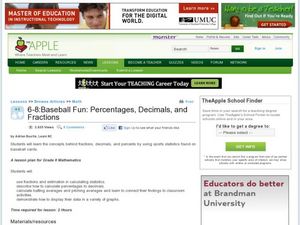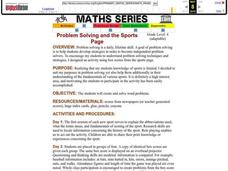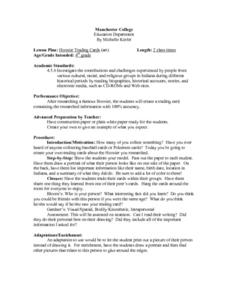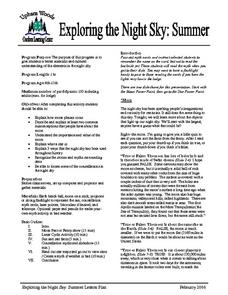Curated OER
6-8 Baseball Fun: Percentages, Decimals, and Fractions
Students practice the concepts behind fractions, decimals, and percents by using sports statistics on baseball cards. In this baseball math lesson, students use fractions and estimation to calculate statistics. Students calculate batting...
Curated OER
Beisbol! Latino Baseball Pioneers and Legends
Students explore Latin America by researching the favorite past time, baseball. In this Latin culture lesson, students identify the leaders in the Latin American baseball movement such as Felipe Alou, Jose Mendze, and the great Roberto...
Curated OER
Student Baseball Cards
Students develop baseball cards with information about their classmates. They interview each other and take a picture for the cards. They share their cards with others in the room.
Curated OER
Rhyme Around Baseball
Students use word family endings to create rhyming words for that word family. In this rhyming lesson, students divide into teams and play a game of word baseball where they create rhyming words for a specific word family.
Curated OER
Cardboard History
Students investigate the history of baseball and create baseball cards based on research they have collected about early baseball players.
Curated OER
Retro Sports Card Self Portrait
Pupils create a "Sports Card Self-Portrait" using the student as model and the sport of their choice as the subject. They use the examples of early baseball cards from the Library of Congress online exhibition "Baseball Cards 1887 to 1914".
Curated OER
Able Am I
Young scholars read the article "Disabled Skier Designs His Way to Be a Daredevil." They discuss using the questions on the lesson plan. Students create large sized baseball cards featuring competitive, disabled athletes.
Curated OER
Problem Solving and the Sports Page
The use of box scores from baseball games is the foundation of this math lesson. Organize your class into groups of four, and give identical box scores from a baseball game that was just played. Have them create word problems from the...
Curated OER
Batting Practice: Using Math to Calculate Baseball Statistics
Students calculate and record batting average, hits, and at bats. In this Batting Practice: Using Math to Calculate Baseball Statistics lesson, students utilize mathematical formulas to determine the career statistics of baseball player...
Curated OER
Let's Make a Deal- Barter 208
Students analyze and evaluate the barter system. They discuss the barter is the proper term for making deals. They participate in a simulation to illustrate each kind of barter.
Curated OER
Biology Biographies
Learners create a project about a famous Biologist in order to appreciate the humanity of the people involved in doing science. They create scientist biography "cards" roughly modeled after baseball cards or create a scrapbook of a...
Curated OER
Satchel Page
Bring a instructional activity about Negro League Baseball to your Black history unit, or any other research unit throughout the year. While the lesson plan itself is simplistic, there are several good ideas that you could use, such as...
Curated OER
Air Pollution Baseball
Students participate in a baseball game in which they answer questions related to air pollution. They answer true and false questions as well. They discuss the impact of air pollution on the environment.
Curated OER
Hoosier Trading Cards
Fourth graders create a trading card depicting information about a famous Indiana resident. Using traditional and internet research, they gather information about a famous Hoosier of their choice. Students use their information to...
Curated OER
Understanding Portion Sizes
Students analyze portion sizes in a healthy diet. In this portion sizes lesson, students complete a food group choices worksheet and identify the correct portion of food. Students work in groups to teach the unit to elementary students....
Curated OER
Exploring the Night Sky: Summer
Students explain how moon phases occur. They describe and explain at least two common misconceptions that people have about the moon. Students explain what a star is. They explain 3 ways that the night sky has been used throughout history.

















